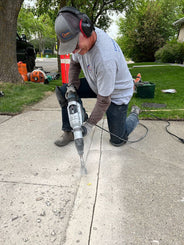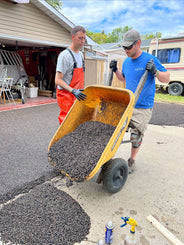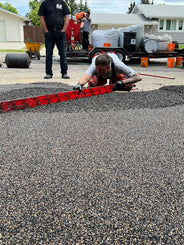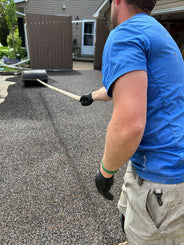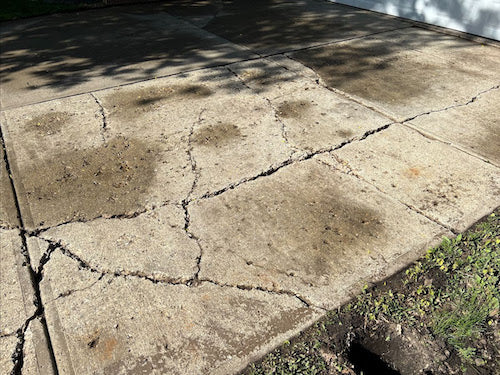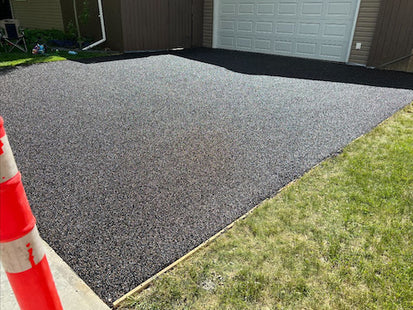PowerPAVE!!
PowerCOAT Canada wants to introduce you to the lucrative world of Rubber Pour in Place Paving!
Rubber Paving is the fastest growing protective coating in the North American market right now and we want to teach you and your team how to apply this amazing coating!
The demand for this type of coating exceeds the number of current applicators in Western Canada as they are booking up to 6 months in advance. In Eastern Canada the market is virtually untouched!
What is Rubber Pour in Place Paving?

Rubber Pour in Place Paving is just that, chunks of rubber that are combined with a urethane binder, poured onto a surface, spread out and compacted to create a paved surface. This creates a durable, safer and attractive surface.
Whether it be a driveway, sidewalk, patio, stairs, deck, or any other outdoor surface, your first thought may be to rip out and replace the old concrete with new concrete, but resurfacing with rubber paving is a great alternative.
Rubber paving is relatively new in the market compared to other paving options. This concrete repair has grown in popularity across North America over the last 25 years.
Rubber Paving has many benefits, including durability, cost, easy and fast installation, maintenance, customization, and safety. Rubber paving is a great paving material for any home or commercial application.
The Benefits of Rubber Paving

Rubber paving has lots of benefits. It’s a super durable material as it is made from recycled truck tires and an industrial urethane binder and it will withstand all weather conditions and wear that it faces.
Read on to learn more about this exciting opportunity!
Rubber Paving is Extremely Cost-Effective.

Lets face it, the biggest concern for any renovation is costs so staying on budget is an important part of any job for you and your customer. Rubber paving is an affordable option for any home or commercial building. All of the features below show why this is the best option for both value and durability.
1. Rubber Paving is much easier to install than concrete, our base and form are already there.
2. Equipment costs for Rubber Paving are minimal compared to concrete installation equipment.
3. You can mould Rubber Paving to any space, unlike concrete where you have to build forms.
Rubber paving costs less to install than concrete as the main ingredient is not a mined product and tires have always been considered to be waste which makes the costs lower. Plus cost savings come from not having to remove the old concrete.
4. The biggest factor is that you won’t have to worry about ripping out and disposing of the old concrete. Rubber paving can be installed right on top, concealing the old pavement as though it were never there. This saves you money on the cost of demolition, disposal and labour.
6. Rubber Paving is a fast application that can be done in a day for a typical driveway so every day it's not raining you can complete a job from start to finish.
7. No long wait periods for your customer to get back onto their driveway either! 3-4 days after application they are good to go.
Rubber paving is environmentally friendly.

Protecting the environment is becoming a very important factor in all of our lives. Rubber paving is made out of rubber tires that have been shredded into rubber crumb. Installing this kind of paving instead of concrete actually provides you and your customer the opportunity to help the environment by keeping the wasted rubber and old concrete out of a landfill.
Helping the planet may not be on your mind when installing new pavement, but using recycled materials in rubber paving can contribute to saving the environment. You may not think it’s much, but the reality is, you’d be contributing to the lessening of waste in landfills and also by not using more concrete you are limiting the amount of CO2 as concrete is a huge CO2 emitter, in fact it is responsible for 5% of global CO2 emissions.
A typical rubber paved 1000 sq ft driveway utilizes about 150 truck tires!!
Rubber paving is very durable and can handle the Canadian Weather Extremes

Canada sees all types of extreme weather and this can play havoc with both exterior substrates and protective coatings. When resurfacing a driveway, sidewalks, patios, or any other outdoor surface, you want a material that’s long-lasting, and rubber paving is the best option. Rubber paving is very flexible and the material is made to expand and contract easily with the change of weather, that way it won’t crack or show other damages.
Shovels and snow blowers do not leave scrape marks on the material. Snow and ice can build up on the rubber pavement but because it does not adhere well to the urethane it is easily removed. Fresh snow can be blown off with just a leaf blower.
If you need to use salt you can and the melted ice will dissipate, leaving your surfaces unharmed. Concrete, on the other hand, will start to crack and spall over time from the salt with freezing and thawing. The added benefit of a mostly black surface is that the sun melts snow and ice quicker, thereby helping clear the surface.
Rubber is a flexible material that is meant to move with the change of the weather, but concrete is rigid which is why it cracks. Your customer will want something more breathable to hold its form through the change of the seasons, and rubber paving will do that.
Last but not least, walking on a rubber paved surface in the extreme cold of winter is very safe due to its texture it is slip resistant.
Rubber Paving is TOUGH and it stands up to typical wear and tear just fine

Weather aside, there are many other factors that typically cause damage to concrete surfaces. Concrete, over time, can wear down from vehicles and other use. Rubber paving is strong, so it won’t chip or buckle. Instead, it bends under pressure while maintaining its strength, no matter how much force is applied. As an example, floor jacks with a car on top of them sink into the rubber and return to the original form once the jack is removed.
Durability is something to look for in a paving product. This isn’t something you want to have to replace or repair often. Instead, you want something to withstand the test of time, no matter the weather or external conditions your paving might endure. Rubber paving has this advantage.
Rubber paving is soft and safe.

Rubber paving is obviously softer than any other paving option. It is slip-resistant, but if a fall does occur, you’ll have a softer landing compared to concrete. This makes it a great choice for playground bases as well. It has some grip to it too, so there’s less slippage with children running and playing. It has impact resistance, almost making the ground have a slight bounce to it. There will be no worrying (or less worrying) about injuries and scrapes with children then if there was sand or concrete pavement. In fact most playground renovations and new builds all require rubber paving to be used.
Rubber paving is incredibly customizable.

A great thing about a material like this is how easy it is to customize it to fit your customers needs and wants. Any color is possible!
You want a paving material that can be easily matched to the style of their home’s exterior which builds upon their home’s curb appeal. Rubber paving gives them many options with its unlimited choice of colors.
They can choose any color or blend they like but black is the most popular color as this is the least expensive option. They also have the ability to use different colors to make patterns or words. Imagine their address number emblazoned in the base of their driveway!
Putting a different color border around the driveway is another option. That way, the pavement will look framed and modern.
Rubber paving improves a home’s curb appeal.

Everyone wants their home to have great curb appeal. Concrete is known for cracking and breaking over time, which takes away the home’s curb appeal. Grass, weeds, and moss can grow and damage the concrete further. Rubber paving will not allow weeds to take root.
If they’re looking to sell their home, rubber paving will help them do that. It looks good to buyers that the driveway or other outdoor spaces have been properly paved. It also will appeal to families looking for a home that’s safe for children. The safety properties of rubber paving and the grip that comes with it will sway a family more so into purchasing a home.
Rubber paving is a proven material.

Rubber paving has proven itself over the last 20 plus years it has been used as a paving option. The materials themselves have gone through many tests in order to ensure that it is a prime choice for pavement and the Urethane Binder only gets better every year.
Through different tests, it is ensured that rubber paving resists fungal and bacteria growth. Rain, sun, snow, and every other weather condition are guaranteed to cause no harm to the surfaces. It’s ensured that the strong grip is anti-skid and anti-slip to keep people safe.
In fact this has become such a popular paving option that all levels of government are now utilizing rubber paving in many government locations as opposed to using normal concrete.
In the picture above you can see how it is being used to fill a large gap in a sidewalk that cracked. Now the sidewalk can shift without worry that a weak point will crack, the rubber will just move with the concrete!
How rubber paving is installed:
This last section is what will convince you to look further into what PowerCOAT is offering. Just how easy is Rubber Paving to install?
3 words... IT'S VERY EASY.
Here are the steps of the installation process:
Pour the rubber into the mixer – In this first step, you pour the dry rubber into the mixer. If you have chosen black only then move to the next step. If you have chosen a color blend then pour the proper amount of each color rubber into the mixer as per the formula.
Add Urethane Binder – This is where you pour the proper amount of Binder, sometimes referred to as glue, into the mixer with the rubber. This Binder will hold the material together, give the paving its flexibility and bond the rubber to the concrete substrate. The binder will also give the mixture its resistance to ensure it’s long-lasting and weather resistant.
Priming the surface – Before laying down the rubber mixture, you may want to prime the surface you’ll be applying the mixture to. You would only need to prime areas of concern which are typically the edges of the driveway. Once the rubber paving is in place the binder will flow down and bond with the concrete.
Pour and level the mixture – Once the above steps are completed, it’s time to pour the mixture into the desired space. After pouring and spreading out the mixture, you’ll want to level it and this is very similar to screeding concrete. It’s important to get this part done immediately after pouring it. Level and pack it down as thick as needed to flatten the surface with a minimum application to be 3/4" thick. It’s easy to mould and get it to that perfect height on your sidewalk, path, driveway, stairs, or playground base. It can be easily flattened down to the perfect level with trowels or rollers.
Watch it dry – After your mixture has been mixed and poured, it’s time to let the surface dry. There may be an odour that comes with mixing and pouring. Don’t worry about the smell: it will fade away over time as the material sets. The dry time for rubber paving is short. In 24 hours you can walk on it and in 3 days you can drive and park your vehicles on it.
You've read a lot and now the question is "Why Get Into the Rubber Paving Industry?"
Ever think of what the next great products will be? Think no more, Rubber Paving is one of them.
The Rubber Paving industry with recycled tires is just in its infancy. Although proven after 25 years of being applied in playgrounds, it is just in the last several years that the residential and commercial markets started to catch on to the benefits.
One of our clients had this to say, "Our Revenues grew 50% in 2020 and then 66% in 2022"
The market is huge and untapped with many undiscovered uses. The areas that can be made safer by resurfacing with rubber paving are endless.
Revenue less Products, Labour & Supplies leaves approx 40% Gross Margin, so the profits are great. Most jobs are completed in 1 day and you are paid.
On an average job of 700 sft, your revenue will be approx. $7,000 and your Gross Margin is $2,800 for 1 days work and then on to the next one!
Only 2 jobs/week = $56,000/month X 6 months = $336,000/season @40% = $134,600 Gross Margin.
There is a small investment for equipment, mostly everyday common tools, and a few specialty tools.
• Truck and trailer to haul minimum 6000-8000 pounds of product
• Mortar Mixer is approx $2500
• Trowels, screeds, rollers and blower are approx $1500
• Jackhammer and concrete saw is approx $2000
• Cleaners & towel lubes, gloves, pails
• Miscellaneous supplies
If you were to start marketing now you will have 33% or more of your season booked by May 31. Applying one surface in a neighbourhood usually leads to several more.
What about training and support?
PowerCOAT Canada is offering a full training program where you will first be given product and marketing information early in the season and second as the weather allows, your team will be on actual job sites learning everything about Rubber Paving from a very experienced training crew.
What about support after the training? We have you covered there as well with 4 months of full technical support. We want you to be successful!
So what will the training and support cost? The product and marketing information and initial hands on training course is $2000 for 2 people. The 4 months of support after training will be $300 per month for only those 4 months. After the 4 months it will be your choice to continue paying for and receiving the support or not. This will allow your company to grow without having the added costs of a franchise fee. Nor will you be tied to a strict contract or limited territory.
Contact PowerCOAT Canada for more information on this incredible opportunity!

